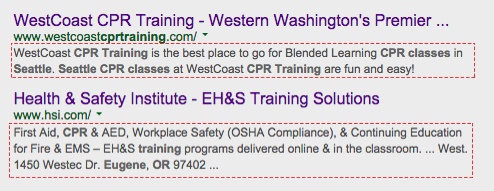Whether you’re looking for the best sushi joint in town, or how to get rid of the nasty stomach bug you acquired from eating said sushi (note to the wise: cheap DOES NOT always equal GOOD sushi!), these weird words in today’s blog title sound like they were made up by an infant, but have become synonymous with finding answers, instantly, easily, and quite literally at your fingertips.
Search Engine Optimization (SEO) is the art of getting your Training Center’s website to the top of someone’s online search results. With the right mix of words, tools, knowledge, and let’s be honest – a little luck, getting your business to the top is easier today then ever before.
How does SEO work?
Before digging into a few tips and tricks on what you can do to improve your SEO, it’s important to understand a bit about how a search works. According to MOZ.com (one of the best resources on SEO):
Search engines have two major functions: crawling and building an index, and providing search users with a ranked list of the websites they've determined are the most relevant.
Web crawlers are constantly searching and indexing the Web; it is a process that literally never ends and is also continually being tweaked by engineers to improve the search process and provide better results to the end user.
So how do you optimize for this ever-changing technology? Again I turn to the experts at MOZ for a great explanation:
We like to say, "Build for users, not for search engines." There are three types of search queries people generally make:
- "Do" Transactional Queries: I want to do something, such as buy a plane ticket or listen to a song.
- "Know" Informational Queries: I need information, such as the name of a band or the best restaurant in New York City.
- "Go" Navigation Queries: I want to go to a particular place on the Internet, such as Facebook or the homepage of the NFL.
When visitors type a query into a search box and land on your site, will they be satisfied with what they find? This is the primary question that search engines try to answer billions of times each day. The search engines' primary responsibility is to serve relevant results to their users. So ask yourself what your target customers are looking for and make sure your site delivers it to them.
It all starts with words typed into a small box.
Improve Your Outward Appearance
 When it comes to your training business’s website getting found, one important thing you can do is use the right words. And one of the best places to start using those words is in your “meta descriptions”:
When it comes to your training business’s website getting found, one important thing you can do is use the right words. And one of the best places to start using those words is in your “meta descriptions”:
Meta descriptions are HTML attributes that provide concise explanations of the contents of web pages. Meta descriptions are commonly used on search engine result pages (SERPs) to display preview snippets for a given page.
While meta descriptions do not get used to rank a website, they are still important in giving a description of your company to those that want to find you on the Web. It’s the meta description that people see, so making yours clear and to the point is mission critical to your SEO success.
As an example here's a bad meta description:
CPR Training in West Chester, Minnesota. CPR, AED, and Safety Training that meets OSHA Standards in Western Minnesota. We are Western Minnesota’s Leading CPR Training Company, train with us today at minnesota.cpr.trainers@westchesterCPR.com.
So why is this bad? The tag includes all of the important information that a searcher needs, but it also indulges in some bad “keyword” techniques. This description uses too many keywords in a small amount of space in the hope of getting a better search result. It was this “keyword stuffing” practice that took meta descriptions out of the equation for page ranking as search engines were eventually redesigned to ignore this sort of thing. But, on the bright side, because of that change we all benefit now from an improved understanding of how results can drive a searcher to choose us over our competition.
Bottom line, a well-formed simple informational paragraph is all that’s needed to achieve quality results:
Meet OSHA Compliance with West Chester, Minnesota’s leaders in CPR, AED, First Aid and Safety Training. 515-311-2452
It’s important to remember too that meta descriptions are page-specific, and a good SEO-minded business owner will be sure that each page has a different description that explains what that particular page is about.
Put Your Meta-Descriptions to Work
Each Content Management System or CMS (Wordpress, Drupal, Hubspot, Marketo, Otis Website Builder, etc.), has a different way for the website owner or webmaster to input meta descriptions. Telling you how to insert meta descriptions is like telling you where to put the battery in your car, without knowing what kind of car you drive. The only thing I can say for sure is that it goes under the hood.
So, depending on how your CMS is setup, you should see a space for the inclusion of a meta description "under-the-hood” of the page you are working on. If you aren’t sure of where to find this space, your CMS should have a tutorial on how to add meta descriptions in their support documents.
While meta descriptions (or “meta tags”) help a user choose you instead of your non-meta-tag loving competition, it is ultimately the words that you place in the body of your webpage that will help you get found by the search engines. But beware; web-crawlers are pretty smart at sniffing out bad SEO practices so using too many keywords, locations, or other things may get you sent into a dark corner of the Web where no one will hear from you again.
The reality is that SEO is hard and getting results can take weeks if not months. But don’t be discouraged; there are a ton of tools and services that you can use to help you get results and make your website awesome:
We wouldn’t write an article on SEO if it weren’t our mission to help you build your business! And in the Summer of 2015 we are making it even easier with OtisFest 2015, a full slate of upgrades coming to your Otis platform.
Starting with the release of the new Otis Pure Look & Feel back at the beginning of May, we are continuing to roll out new features and upgrades that will not only help you administer your business but also help you grow it!
Just a few things to look forward to:
- Referral Program << Click Here to Register for the Upcoming Webinar
- Equipment Tracker
- Website Builder
- New Online Store
- More…
Stay up-to-date on Otisfest and all the latest from HSI right here on our blog!
Subscribe to the Blog






.png?width=600&name=HSI-CTA-EmergencyCareTraining%20(1).png)











Comments